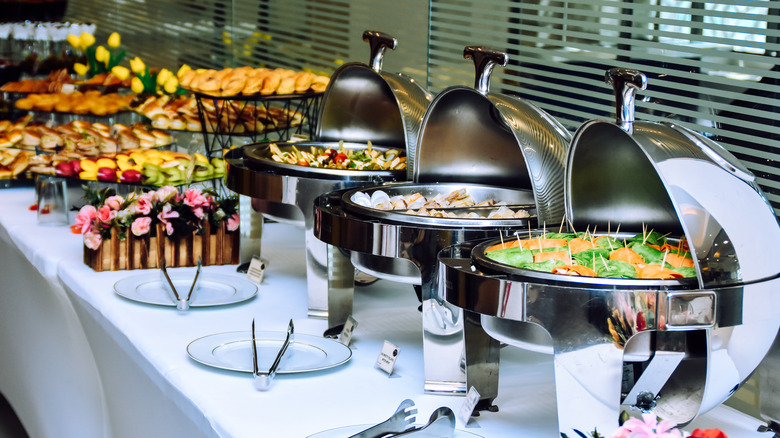The Historic Inspiration For Buffets In The US
What's more American than a mashed potato bar and a buffet that places spaghetti next to Jell-O and fruit salad? The buffet is a cultural symbol of the excess of choice in the U.S. Want fried chicken with a side of clam chowder? You can do that. The ability to eat as much as you want of whatever you want is a power that Faust would trade his soul for. And yet, this inherently American phenomenon is not so American in origin.
The word buffet is derived from the word "bufet," a sideboard usually placed near a dining table for serving that also stored plates and linens (via Grammarist). Eventually, the English borrowed this word to refer to the food served on the sideboard. In retrospect, the word seems to mean the opposite of what it used to represent. Today, we take our plates to the long line of buffet trays, but back in the day, the buffet was a small side table that was there to supplement the served courses. So how did the concept evolve to become the endless dishes at Caesars Palace's famous Bacchanal Buffet or a Sizzler?
A Swedish feast
The Swedish smörgåsbord is the earliest form of the buffet. So sprawling was this arrangement of foods, that Americans who partook were hooked immediately. The smörgåsbord originally started off as a brännvinsbord, an appetizer table with 10 to 15 dishes that included cheeses, bread, cold meats, herring salad, and fried pork, according to "Life Is a Banquet" by Edward Blom. By the 18th century, the Swedish expanded the brännvinsbord to entrées, which gave rise to the modern smörgåsbord, per Nordic Recipe Archive. Now the word has been borrowed to mean a hodgepodge of different foods, but smörgåsbord literally means "bread and butter table." Unlike the American buffets that were inspired by them, smörgåsbords were reserved for the elite and showcased the local ingredients of the region.
This style of dining became popularized during the 1912 Stockholm Olympics, where smörgåsbord went from appetizer to the main course. A couple of decades later, it was introduced at the 1939 World's Fair in New York (via the Ingebretsen's Blog). From there, the American version of the smörgåsbord was born: the all-you-can-eat buffet. Herb McDonald brought the buffet to Las Vegas in the 1940s where his Buckaroo Buffet flourished and became the standard restaurant style at casinos. Americans thus took the Swedish table spread and supersized it, as we're wont to do.

